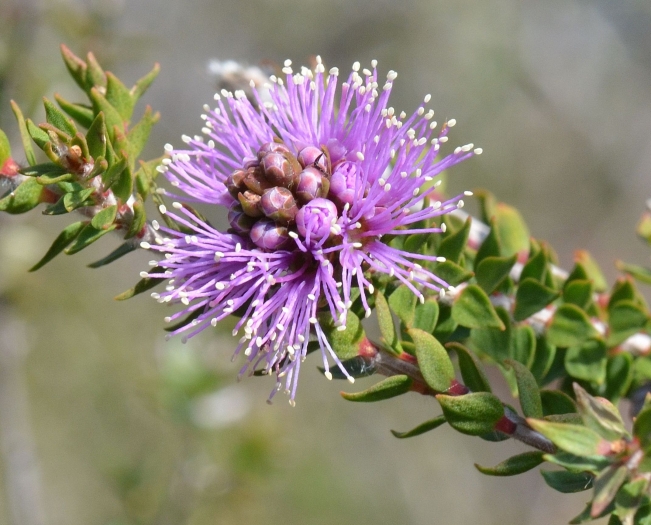Swamp Honey Myrtle
(Melaleuca squamea)
Swamp Honey Myrtle (Melaleuca squamea)
/
/

James Duggan
CC BY 4.0
Image By:
James Duggan
Recorded By:
Copyright:
CC BY 4.0
Copyright Notice:
Photo by: James Duggan | License Type: CC BY 4.0 | License URL: http://creativecommons.org/licenses/by/4.0/ | Occurence ID: https://www.gbif.org/occurrence/1632954036 | Publisher: Atlas of Living Australia |























Estimated Native Range
Summary
Melaleuca squamea, commonly known as Swamp Honey Myrtle, is an evergreen shrub native to the coastal swamps and wetlands of Eastern and Southeastern Australia, including Tasmania. It is an erect shrub that thrives in damp and swampy habitats, often found in heathlands and along watercourses. Swamp Honey Myrtle typically grows to 2 m (7 ft) in height but can occasionally reach up to 6 m (20 ft). Its bark is corky or rough and scaly, and it has stiff, rather erect branches. The foliage is dense with crowded leaves that provide a lush appearance. The flowers, ranging from lilac to mauve and sometimes white or yellowish, are showy and arranged in heads or short spikes at the ends of branches that continue to grow after flowering. Each head contains 3 to 26 individual flowers and is up to 20 mm (0.8 in) in diameter, with petals that are 1.5–3 mm (0.06–0.1 in) long and fall off as the flower matures. Flowering occurs in spring, and the plant produces woody, almost spherical capsules as fruit, which remain unopened on the stems for several years.
Swamp Honey Myrtle is valued for its ability to serve as a screen or background plant in gardens. It is frost and drought tolerant, making it a resilient choice for challenging conditions. It survives well in poorly drained soils but does not fare well in limy or saline soils. For optimal growth, it prefers full sun to part shade and requires low amounts of water, thriving in soils with slow to medium drainage. This species is not commonly associated with significant diseases or pests, making it a low-maintenance option for gardeners. However, it is important to note that it can become weedy if not managed properly in cultivation.CC BY-SA 4.0
Swamp Honey Myrtle is valued for its ability to serve as a screen or background plant in gardens. It is frost and drought tolerant, making it a resilient choice for challenging conditions. It survives well in poorly drained soils but does not fare well in limy or saline soils. For optimal growth, it prefers full sun to part shade and requires low amounts of water, thriving in soils with slow to medium drainage. This species is not commonly associated with significant diseases or pests, making it a low-maintenance option for gardeners. However, it is important to note that it can become weedy if not managed properly in cultivation.CC BY-SA 4.0
Plant Description
- Plant Type: Shrub
- Height: 4-6 feet
- Width: 3-5 feet
- Growth Rate: Moderate
- Flower Color: Purple
- Flowering Season: Winter, Spring
- Leaf Retention: Evergreen
Growth Requirements
- Sun: Full Sun, Part Shade
- Water: Low
- Drainage: Slow, Medium
Common Uses
Bee Garden, Bird Garden, Butterfly Garden, Deer Resistant, Fragrant, Hedges, Hummingbird Garden, Low Maintenance, Rabbit Resistant, Showy Flowers
Natural Habitat
native to the coastal swamps and wetlands of Eastern and Southeastern Australia, including Tasmania
Other Names
Common Names: Swamp Paperbark, Fuzzy Swamp Honey-Myrtle, Swamp Melaleuca
Scientific Names: , Melaleuca squamea, Melaleuca ottonis, Melaleuca squamea var. glabra, Myrtoleucodendron squameum,
GBIF Accepted Name: Melaleuca squamea Labill.